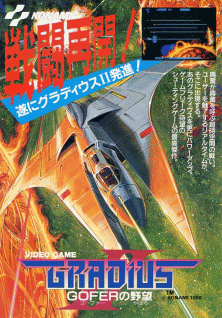Gradius II
| Gradius II | |
|---|---|
|
Japanese arcade flyer | |
| Developer(s) | Konami |
| Publisher(s) |
Konami
|
| Director(s) |
Arcade version Hiroyasu Machiguchi Famicom version Shigeharu Umezaki |
| Programmer(s) |
Arcade version Toshiaki Takatori PC Engine version Koji Igarashi |
| Composer(s) |
Arcade version Shinji Tasaka Motoaki Furukawa Kenichi Matsubara Seiichi Fukami Famicom version Hidenori Maezawa Yukie Morimoto |
| Series | Gradius |
| Platform(s) |
|
| Release date(s) |
March 24, 1988
|
| Genre(s) | Scrolling shooter |
| Mode(s) | Single-player |
| Cabinet | Upright |
| Arcade system | Konami Twin 16 |
| Display | Raster, 320 x 224, horizontal orientation |
Gradius II: Gofer no Yabou (グラディウスII GOFERの野望 Gradiusu Tsū: Gofā no Yabō, Gradius II: Gofer's Ambition), known as Vulcan Venture in arcades outside Japan, is a horizontally-scrolling shooter originally released for the arcades in Japan in 1988. It is the sequel to original Gradius and was succeeded by Gradius III: From Legend to Myth. Ports of Gradius II were released for the Family Computer (under the shortened title of Gradius II), PC-Engine Super CD-ROM², and the X68000 in Japan. The original arcade version is also included in the Gradius Deluxe Pack compilation for the PlayStation and Sega Saturn and in Gradius Collection for the PlayStation Portable.
Gameplay
The player returns as the role of the pilot of the Vic Viper spaceship to battle the second onslaughts of the Bacterion Empire, under the new leadership of Gofer, the giant head. Gradius II has kept the gameplay from the original game, but infused it with enhancements brought from the spin-off, Salamander (Life Force). This is primarily evident in two of the weapons configurations that are selectable. Another first in the series was the inclusion of the "boss rush" (also known as "boss parade" or "boss alley"), a level designed entirely with only boss confrontations.
Gradius II retains the selection bar from Gradius, but now the player can choose between four different weapon configurations and progressions. All schemes have speed-up and multiples (Options), but have differing 'Missile', 'Double' (laser), and 'Laser' weapons. The player can have at most four multiples. Additionally, there are also two types of shielding to choose from: shield and forcefield. The shield option adds more durability, but only for the front of the Vic Viper, while the forcefield adds protection for the entire spacecraft, albeit only against three hits. In the Famicom version, choosing another multiple after four will make the four multiples to move around the spacecraft for 15 seconds; force field is the only shielding available for protection of the entire spacecraft, withstanding three hits and it is included in four different weapon configurations and progressions; and 'Double' and 'Laser' have to be activated twice to achieve full performance.
The PC engine version offers an different ending screen after completing the game, depending on the difficulty select.
Release
The game was first ported to the Family Computer in 1988 and was never released outside Japan. Presumably this was due to the fact that the Famicom version employed a custom memory mapper dubbed the VRC4,[1] which enhanced some of the game's graphics and sounds, such as animation and voices, thus converting the game to a standard memory mapper (as Konami later did with Castlevania III: Dracula's Curse) would have been too time-consuming (since the original Gradius was not as popular overseas as it was in Japan).
A PC-Engine Super CD-ROM² port was later released only in Japan in 1992. The graphics remained nearly unaltered, the background music is mostly the arcade version's soundtrack in redbook audio format, and one additional stage was added that is similar to the temple stage in the NES version of Life Force and the first stage of Gradius III: From Legend to Myth.
Gradius II was later re-released in the Japanese exclusive Gradius Deluxe Pack for the PlayStation, Sega Saturn and Microsoft Windows in 1996, and for the first time a worldwide release on the Gradius Collection for the PlayStation Portable in 2006. No version of Gradius II saw a release in North America until its inclusion in the Gradius Collection in 2006. The Famicom and PC Engine ports were re-released for the Wii Virtual Console in 2007, the latter getting an international release.
Reception
IGN gave the Virtual Console release of the PC Engine version an 8 out of 10, praising the ability to choose which power-ups the player character has access to before entering a stage and the inclusion of useful cheat codes "to offset the otherwise potentially overwhelming difficulty".[2]
Nintendo Life also gave the PC Engine version an 8 out of 10, praising the new additional features that is not present in arcade version like the introduction sequence and the new exclusive stage.[3]
References
- ↑ "Gradius II promotional flyer". DISK-KUN.
- ↑ Thomas, Lucas M. (November 4, 2008). "Gradius II: Gofer no Yabou Review". IGN. Retrieved 17 October 2014.
- ↑ "Review: Gradius II: Gofer no Yabou (TG-16)". Nintendo Life. May 3, 2008.
